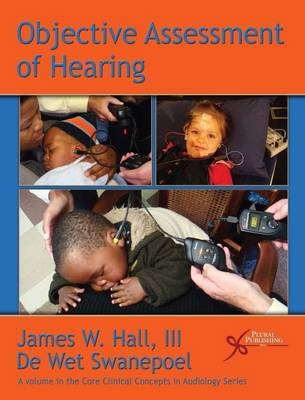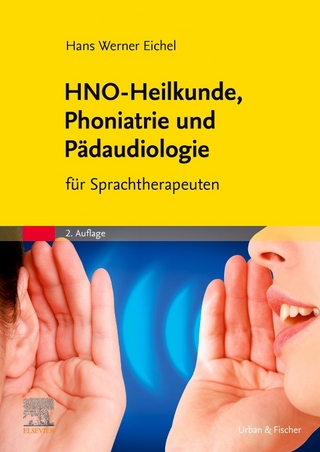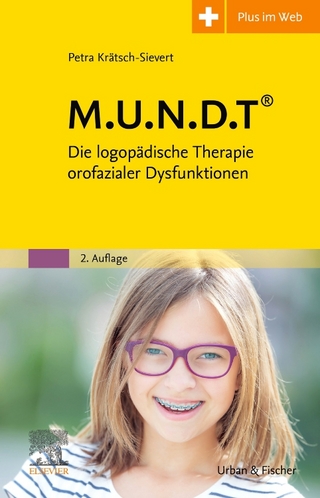
Objective Assessment of Hearing
Plural Publishing Inc (Verlag)
978-1-59756-353-6 (ISBN)
This book bridges the gap between theory and clinical application for electro-acoustic and electro-physiologic assessment of hearing loss across the age range. Strategies and techniques for screening and diagnosis of hearing loss are presented clearly and simply. The authors incorporate findings of accumulated clinical experience and recent clinical research in a readable review of electro-acoustic measures (immittance measures and otoacoustic emissions) and electro-physiologic measures (electrocochleography, ABR and ASSR) that are essential for best practice in audiology today. This book is a one-stop resource for clinicians who are responsible for the diagnostic auditory assessment of children and adults.
James Hall III, Ph.D. Dr. James W. Hall III is Clinical Professor in the Department of Communicative Disorders at the University of Florida in Gainesville, where he maintains a clinical practice and is an instructor in the Doctor of Audiology on-site and distance learning programs. Dr. Hall's main research interests are auditory neurophysiology, auditory processing disorders, early identification of hearing loss in infants, and tinnitus/hyperacusis. Dr. Hall lectures internationally on these topics. He is the author of numerous journal articles, monographs, or book chapters, as well as the Handbook of Auditory Evoked Responses and Audiologists' Desk Reference Volumes I and II, the Handbook of Otoacoustic Emissions and the New Handbook of Auditory Evoked Responses. De Wet Swanepoel, PhD De Wet Swanepoel, PhD, is an Associate Professor and clinical research audiologist at the Department of Communication Pathology, University of Pretoria, South Africa, and Adjunct Professor at the University of Texas at Dallas, Callier Center for Communication Disorders. His research and clinical interests are in the field of early identification and diagnosis of infants with hearing loss, including electro-physiologic and electro - acoustic assessment procedures. Dr. Swanepoel also has an interest in auditory functioning in special populations such as persons infected with HIV/AIDS. He has received several awards and research grants for his work in these areas from institutions like the Medical Research Council and National Advisory Council on Innovation. He has published numerous peer-reviewed articles and regularly presents at international conferences. He is also a regional editor for the International Journal of Audiology and reviews for several international journals.
Chapter 1: Rationale for Objective Hearing Assessment A Word About Terminology Important Terms and Concepts Detection versus Diagnosis Clinical Limitations of Behavioral Audiometry Cross-Check Principle Revisited Chapter 2 Aural Immittance Measurements Introduction Terminology Historical Perspective Current Status of Immittance Measures Functional Anatomy Introduction External Ear Canal Middle Ear Cochlear and Retrocochlear Pathways Identification (Screening) of Auditory Dysfunction Tympanometry Introduction Jerger Tympanogram Classification System Gradient Single versus Multi-Frequency and Multi-Component Tympanometry Wide Band Reflectance Acoustic Reflex Thresholds for Broadband Noise Signals Diagnosis of Auditory Dysfunction Introduction Tympanometry Findings in Auditory Dysfunction Toynbee and Valsalva Techniques Sensitivity Prediction by the Acoustic Reflex (SPAR) Other Acoustic Reflex Predictive Techniques Contraindications to Acoustic Reflex Measurement Diagnosis Value of Patterns of Aural Immittance Findings Introduction Case A: Vertical Acoustic Reflex Pattern (Mild Conductive) Case B: "Inverted L" Acoustic Reflex Pattern (Moderate Conductive) Case C: Vertical Acoustic Reflex Pattern (Facial Nerve Disorder) Case D: Diagonal Acoustic Reflex Pattern (Sensory) Case E: Diagonal Acoustic Reflex Pattern (Neural) Case F: Inverted L Acoustic Reflex Pattern (Neural) Case G: Horizontal Acoustic Reflex Pattern (Brainstem) Case H: "Uni-Box" Acoustic Reflex Pattern (Brainstem) Chapter 3 Otoacoustic Emissions Introduction Screening for Hearing Loss Introduction OAE Test Protocols for Newborn Hearing Screening Pass versus Refer Criteria Simple Steps for Minimizing Refer Rate Combined OAE and Admittance/Reflectance Technologies OAE Screening with Tele-Health Technology Newborn Hearing Screening with OAE and ABR Technology Introduction Two-Step Hearing Screening with OAE and ABR Combined OAE and ABR Hearing Screening School Age and Pre-School Screening Introduction School-Age Children Pre-School Children Estimation of Hearing Loss Introduction Estimating Hearing Loss with OAEs Differences Between OAE and Audiogram Findings Clinical Considerations and Concerns Subject (Non-Pathological) Factors Pathologic Factors Chapter 4 Electrocochleography (ECochG) Introduction Test Protocol Estimation of Hearing Thresholds Diagnostic Applications of ECochG Enhancement of ABR Auditory Neuropathy Clinical Considerations and Constraints Subject Factors Pathologic Factors Concluding Comment Chapter 5 Auditory Brainstem Response (ABR) Hearing Screening for Identification of Hearing Loss Automated ABR Background Clinical Findings Estimation of Hearing Thresholds Air-Conduction Click-Elicited ABR Measurement Rationale A Practical Test Protocol Bone Conduction Click-Elicited ABR Measurement Rationale and Indications A Practical Bone Conduction ABR Protocol Frequency-Specific (Tone Burst) ABR Measurement Rationale A Practical Tone Burst ABR Protocol Analysis and Interpretation Introduction Steps in ABR Analysis Analyses of ABR Waveforms for Air Conduction Click Stimulation Analyses of ABRs for Bone Conduction Stimulation Analyses of Frequency-Specific ABRs (Tone Burst Stimulation) Clinical Considerations and Constraints Non-pathologic Factors Pathologic Factors Noise, Sedation, and Anesthesia ABR Measurement Without Sedation or Anesthesia Plotting Electrophysiologically-Estimated Auditory Thresholds Chapter 6 Auditory Steady State Response (ASSR) Historical Perspective on the Auditory Steady-State Response Defining the Auditory Steady-State Response Introduction Response Generation Neural Generators Stimulus Characteristics Type of Stimuli Presentation of Stimuli Response Acquisition Improving the Signal-to-Noise Ratio Response Analysis Spectral Analysis Approach Phase Analysis Approach Considerations in Response Detection Subject Factors Age Sleep Anesthesia Attention Internal Noise Objective Hearing Assessment with the Auditory Steady-State Response Hearing Screening Estimating Behavioral Threshold Threshold Accuracy Adults Infants Auditory Neuropathy Artifactual Responses Bone Conduction Auditory Steady-State Responses Sound-Field ASSR Clinical Protocols and Equipment Future Applications of the Auditory Steady-State Response Chapter 7 Recommendations for Objective Identification and Estimation of Hearing Loss Introduction Recommendations for Detection Newborns and infants Combined OAE/ABR Infant Hearing Screening Pre-School and School-Age Children Recommendations for Diagnosis Infants Younger Than 6 Months Infants 6 to 36 Months Children and Adults Test-Battery Approach New Directions for Research Detection of Hearing Loss Diagnosis of Hearing Loss Chapter 8 Illustrative Case Reports and Clinical Findings Introduction Case: Frequency-Specific ABR for an Infant Under Melatonin-Induced Sleep CASE: ABR Evaluation of an Awake Child CASE: Auditory Neuropathy and Conductive Hearing Loss CASE: Bilateral Conductive Loss CASE: Unilateral Sensory Hearing Loss CASE: Bilateral Profound Sensory Hearing Loss REFERENCES
| Erscheint lt. Verlag | 1.1.2010 |
|---|---|
| Zusatzinfo | 2 colour illustrations |
| Verlagsort | San Diego |
| Sprache | englisch |
| Maße | 178 x 254 mm |
| Gewicht | 590 g |
| Themenwelt | Medizin / Pharmazie ► Gesundheitsfachberufe ► Logopädie |
| Medizin / Pharmazie ► Medizinische Fachgebiete ► HNO-Heilkunde | |
| ISBN-10 | 1-59756-353-6 / 1597563536 |
| ISBN-13 | 978-1-59756-353-6 / 9781597563536 |
| Zustand | Neuware |
| Informationen gemäß Produktsicherheitsverordnung (GPSR) | |
| Haben Sie eine Frage zum Produkt? |
aus dem Bereich


